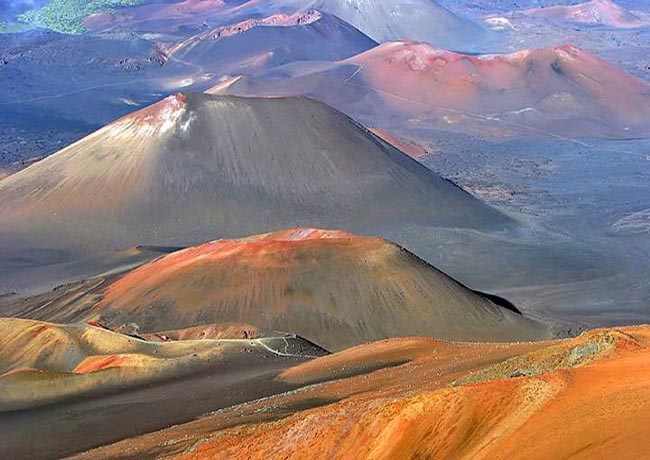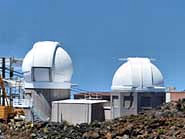|
Scenic USA - Hawaii Haleakala Crater |

| Photo by Ron Lutz II Inset photos - Ben Prepelka |
Shield volcanoes, resembling the shape of a warriorís shield,  are primarily made up of non-violent basaltic lava flows. Mauna Loa, one of the largest volcanoes on Earth, is one of five shield volcanoes that make up the island of Hawaii. Neighboring Maui, made up of two shield volcanoes, exists entirely from mountain building volcanic activity, which holds true for the entire string of Hawaiian Islands. The massive shield volcano, Haleakala, forms the eastern half of Maui. Topped out at 10,023 feet (3055 m), the Haleakala Crater no longer holds its original shape, blanketed by more recent cinder cones and highly eroded by tropical rains. This dramatic view highlights one of a line of young cinder cones and lava flows that extend across immense Haleakala Crater. The most recent eruptions are thought to have occurred at the end of the 18th century, around the time explorers La Perouse and Vancouver arrived.
are primarily made up of non-violent basaltic lava flows. Mauna Loa, one of the largest volcanoes on Earth, is one of five shield volcanoes that make up the island of Hawaii. Neighboring Maui, made up of two shield volcanoes, exists entirely from mountain building volcanic activity, which holds true for the entire string of Hawaiian Islands. The massive shield volcano, Haleakala, forms the eastern half of Maui. Topped out at 10,023 feet (3055 m), the Haleakala Crater no longer holds its original shape, blanketed by more recent cinder cones and highly eroded by tropical rains. This dramatic view highlights one of a line of young cinder cones and lava flows that extend across immense Haleakala Crater. The most recent eruptions are thought to have occurred at the end of the 18th century, around the time explorers La Perouse and Vancouver arrived.
Haleakala National Park, covering 30,000 acres of eastern Maui, offers visitors a vast range of environments to explore.  Views vary from stark mountain tops to the lush forests of lower elevations. Separate visitor centers cover these unique ecosystems, with the Haleakala Visitor Center (9740 foot elevation) a popular stop to see the summit sunrise. Itís a long and winding road to the top, but outstanding views in all directions make this a trip of a lifetime.
Views vary from stark mountain tops to the lush forests of lower elevations. Separate visitor centers cover these unique ecosystems, with the Haleakala Visitor Center (9740 foot elevation) a popular stop to see the summit sunrise. Itís a long and winding road to the top, but outstanding views in all directions make this a trip of a lifetime.
Hawaiian Island eruptions had been occurring for nearly a million years. Taking into account the portion of the islands that lie beneath the sea,  volcanism created the tallest mountains on earth, measuring over 30,000 feet. Despite the high winds and cinder-desert climate on these mountaintops, the Haleakala ahinahina or silversword is a true survivor. Thought to have arrived long ago, witnessing a millennium volcanic activity, the silversword plant lives up to 50 years in this harsh environment. It flowers only once in a lifetime, broadcasting thousands of seeds into the wind. Once covering Haleakala, the old silversword faces new threats from livestock and insects that prey on the plant's pollinators.
volcanism created the tallest mountains on earth, measuring over 30,000 feet. Despite the high winds and cinder-desert climate on these mountaintops, the Haleakala ahinahina or silversword is a true survivor. Thought to have arrived long ago, witnessing a millennium volcanic activity, the silversword plant lives up to 50 years in this harsh environment. It flowers only once in a lifetime, broadcasting thousands of seeds into the wind. Once covering Haleakala, the old silversword faces new threats from livestock and insects that prey on the plant's pollinators.
Area Map

|
Nearby Points of Interest |
|
Copyright © 2022 Benjamin Prepelka
All Rights Reserved
